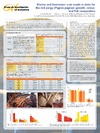Identificador persistente para citar o vincular este elemento:
https://accedacris.ulpgc.es/jspui/handle/10553/5883
| Campo DC | Valor | idioma |
|---|---|---|
| dc.contributor.author | García Romero, Josefa | en_US |
| dc.contributor.author | Robaina, L. | en_US |
| dc.contributor.author | Kalinowski Herrera, Carmen Tatiana | en_US |
| dc.contributor.author | Fernandez-Palacios, H. | en_US |
| dc.contributor.author | Izquierdo, Marisol | en_US |
| dc.date.accessioned | 2011-07-21T02:31:00Z | - |
| dc.date.accessioned | 2018-06-18T06:49:46Z | - |
| dc.date.available | 2011-07-21T04:00:20Z | - |
| dc.date.available | 2018-06-18T06:49:46Z | - |
| dc.date.issued | 2006 | en_US |
| dc.identifier.uri | https://accedacris.ulpgc.es/handle/10553/5883 | - |
| dc.description.abstract | Red porgy, Pagrus pagrus, is one of the marine fish species for the aquaculture diversification in the Mediterranean and Mid Atlantic coasts. Relevance of its nutrition has been demonstrated not only from growth and body composition, but also because it?s important role in fish skin colour and carotenoids deposition (Kalinowski et al., 2005; Pavlidis et al., 2006). Present study evaluate the influence of two different crab meals by products, marine and freshwater origin, as protein and pigment sources in experimental diets for red porgy and its effects on fish growth and feed utilization parameters, fish skin colour and fish composition. Both crab meals used in present study are suitability as partial replacers of fish meal in diets for the red porgy. Dietary inclusion levels of 10% and 20% of the dietary protein from these meals have no detrimental effects on growth and feed utilization parameters respect to a fish meal based diet, with high improvements in fish skin redness and skin colour saturation by increased inclusion levels. Digestibility and retention efficiency parameters are being analyzing at the moment. | en_US |
| dc.format | application/pdf | es |
| dc.language | eng | en_US |
| dc.rights | by-nc-nd | es |
| dc.source | XII International Symposium on Fish Nutrition & Feeding, 28 May - 1 June 2006, Biarritz, France | en_US |
| dc.subject | 310502 Piscicultura | en_US |
| dc.title | Marine and freshwater crab meals in diets for the red porgy (Pagrus pagrus): growth, colour, and fish composition | en_US |
| dc.type | info:eu-repo/semantics/conferenceobject | en_US |
| dc.type | Conference poster | en_US |
| dc.identifier.absysnet | 629060 | - |
| dc.investigacion | Ciencias | en_US |
| dc.rights.accessrights | info:eu-repo/semantics/openAccess | es |
| dc.type2 | Póster de congresos | en_US |
| dc.utils.revision | Sí | en_US |
| dc.identifier.ulpgc | Sí | es |
| item.fulltext | Con texto completo | - |
| item.grantfulltext | open | - |
| crisitem.author.dept | GIR Grupo de Investigación en Acuicultura | - |
| crisitem.author.dept | IU de Investigación en Acuicultura Sostenible y Ecosistemas Marinos (IU-Ecoaqua) | - |
| crisitem.author.dept | Departamento de Biología | - |
| crisitem.author.dept | GIR Grupo de Investigación en Acuicultura | - |
| crisitem.author.dept | IU de Investigación en Acuicultura Sostenible y Ecosistemas Marinos (IU-Ecoaqua) | - |
| crisitem.author.dept | Departamento de Biología | - |
| crisitem.author.orcid | 0000-0003-4857-6693 | - |
| crisitem.author.orcid | 0000-0003-1410-8154 | - |
| crisitem.author.orcid | 0000-0003-4297-210X | - |
| crisitem.author.parentorg | IU de Investigación en Acuicultura Sostenible y Ecosistemas Marinos (IU-Ecoaqua) | - |
| crisitem.author.parentorg | IU de Investigación en Acuicultura Sostenible y Ecosistemas Marinos (IU-Ecoaqua) | - |
| crisitem.author.fullName | Robaina Robaina, Lidia Esther | - |
| crisitem.author.fullName | Fernández Palacios, Hipólito | - |
| crisitem.author.fullName | Izquierdo López, María Soledad | - |
| Colección: | Póster de congreso | |
Visitas
46
actualizado el 10-ene-2026
Descargas
22
actualizado el 10-ene-2026
Google ScholarTM
Verifica
Comparte
Exporta metadatos
Los elementos en ULPGC accedaCRIS están protegidos por derechos de autor con todos los derechos reservados, a menos que se indique lo contrario.
